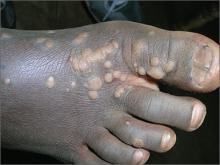The FP diagnosed this patient with common warts. While any child can develop a large cluster of warts, the FP decided to ask more about the family’s health in case this was a sign of immunosuppression. The mother acknowledged that she was positive for human immunodeficiency virus (HIV) and that the father had passed away from acquired immune deficiency syndrome (AIDS). She consented to HIV testing for her son and he tested positive. Unfortunately, the mother did not have antiretroviral therapy during her pregnancy with this child.
While there were resources within the village for HIV treatment, there were no resources for wart treatment. Because the child could receive treatment for HIV, the warts could resolve on their own as his immune system improved. Even immunocompetent children will often see their warts completely disappear over time.
In settings with greater resources, typical treatments for common warts include: cryotherapy, topical salicylic acid, topical cantharidin, topical imiquimod, and intralesional immunotherapy. Intralesional immunotherapy can be performed with Candida antigens, the measles, mumps, and rubella vaccine, and a purified protein derivative (as used for tuberculosis testing). Other less commonly used treatments include lasers, photodynamic therapy, contact immunotherapy, hypnosis, oral cimetidine, duct tape, and surgery.
The reason there are so many treatments is that no single treatment works well enough in most cases. Based on a Cochrane review, the strongest evidence supports topical salicylic acid and cryotherapy.1 Immunosuppressed patients can sometimes have the most recalcitrant warts, but treatment of the immune system, along with typical treatment options, can still be successful.
1. Gibbs S, Harvey I, Sterling JC, et al. Local treatments for cutaneous warts. Cochrane Database Syst Rev. 2001;(2):CD001781.
Photos and text for Photo Rounds Friday courtesy of Richard P. Usatine, MD. This case was adapted from: Mayeaux, EJ. Common warts. In: Usatine R, Smith M, Mayeaux EJ, et al, eds. Color Atlas of Family Medicine. 2nd ed. New York, NY: McGraw-Hill; 2013:749-754.
To learn more about the Color Atlas of Family Medicine, see: www.amazon.com/Color-Family-Medicine-Richard-Usatine/dp/0071769641/
You can now get the second edition of the Color Atlas of Family Medicine as an app by clicking on this link: usatinemedia.com


